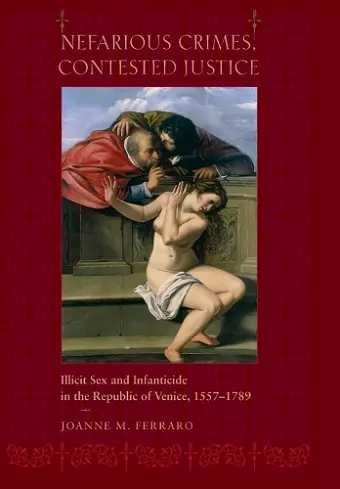Nefarious Crimes, Contested Justice
Illicit Sex and Infanticide in the Republic of Venice, 1557–1789
Format:Hardback
Publisher:Johns Hopkins University Press
Published:16th Dec '08
Currently unavailable, and unfortunately no date known when it will be back

Ferraro opens up what has really been a hidden world... She reconstructs each case with often fascinating and disturbing detail. This is done so well that one frequently feels as if one is hearing the voices of the testimony and following the case as it was laid out in court. -- Guido Ruggiero, author of Machiavelli in Love: Sex, Self, and Society in the Italian Renaissance and Binding Passions: Tales of Magic, Marriage and Power at the End of the Renaissance
In uncovering these hidden sex crimes, Ferraro exposes the further abuse of women by both the men who perpetrated these illegal acts and the courts that prosecuted them.This captivating history exposes a clandestine world of family and community secrets-incest, abortion, and infanticide-in the early modern Venetian republic. With the keen eye of a detective, Joanne M. Ferraro follows the clues in individual cases from the criminal archives of Venice and reconstructs each one as the courts would have done according to the legal theory of the day. Lawmakers relied heavily on the depositions of family members, neighbors, and others in the community to establish the veracity of the victims' claims. Ferraro recounts this often colorful testimony, giving voice to the field workers, spinners, grocers, servants, concubines, midwives, physicians, and apothecaries who gave their evidence to the courts, sometimes shaping the outcomes of the investigations. Nefarious Crimes, Contested Justice also traces shifting attitudes toward illegitimacy and paternity from the late sixteenth through the eighteenth centuries. Both the Catholic Church and the Republic of Venice tried to enforce moral discipline and regulate sex and reproduction. Unmarried pregnant women were increasingly stigmatized for engaging in sex. Their claims for damages because of seduction or rape were largely unproven, and the priests and laymen they were involved with were often acquitted of any wrongdoing. The lack of institutional support for single motherhood and the exculpation of fathers frequently led to abortion, infant abandonment, or infant death. In uncovering these hidden sex crimes, Ferraro exposes the further abuse of women by both the men who perpetrated these illegal acts and the courts that prosecuted them.
This is a book which repays careful study and illuminates a world which most of its inhabitants would have preferred to have kept hidden. Reviews in History This is an elegantly written concise and clear book that will be a fascinating read for scholars and students alike. -- Tessa Storey Law and History Review This is an elegantly written, concise, and clear book that will be a fascinating read for scholars and students alike. Law and History Review This book, rich in documentary evidence and level-headed when it comes to dispensing overarching theory, paints a vivid portrait of the early-modern conceptualization and regulation of female sexuality. It recognizes the larger cultural shifts-the new censoriousness provided by the Council of Trent, the evolution of Italian cultural and legislative attitudes-but its main purpose is to unearth the poignant, detailed stories of Italian women who found themselves in awful situations. In this endeavour, Ferraro has succeeded triumphantly. Journal of European Studies A thoroughly enjoyable and informative study that will be a great benefit to scholars of Venice and the Mediterranean, crime and criminal procedure, the Reformations, and the history of sexuality. -- Jane Byars Journal of Social History One of the great strengths of the microhistorical method that Ferraro adopts is that it provides a window into the world of individuals long thought to have, at best, muffled historical voices... The work sheds light on social and sexual fissures in early modern families as well as on the function and limitations of early modern justice. It is perhaps an unintended consequence, but a poignant one, that these themes-sexuality in the priesthood, domestic violence, the legal challenges of rape, and the control of women's bodies-resonate in our own times. -- Holly S. Hurlburt Journal of Modern History This is truly a fascinating book. -- Hiram Kumpar Sixteenth Century Journal The compelling stories in this well-written book provoke many thoughts and questions which will doubtless interest many historians of Venice, crime, justice, gender and the family. European History Quarterly
ISBN: 9780801889875
Dimensions: 229mm x 152mm x 21mm
Weight: 499g
272 pages